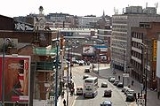
Digbeth
Encyclopedia

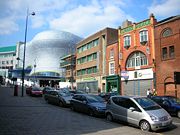
Birmingham
Birmingham is a city and metropolitan borough in the West Midlands of England. It is the most populous British city outside the capital London, with a population of 1,036,900 , and lies at the heart of the West Midlands conurbation, the second most populous urban area in the United Kingdom with a...
, England
England
England is a country that is part of the United Kingdom. It shares land borders with Scotland to the north and Wales to the west; the Irish Sea is to the north west, the Celtic Sea to the south west, with the North Sea to the east and the English Channel to the south separating it from continental...
. Following the destruction of the Inner Ring Road, Digbeth is now considered a district within Birmingham City Centre
Birmingham City Centre
Birmingham city centre is the business, retail and leisure hub of Birmingham, England. Following the removal of the Inner Ring Road, the city centre is newly defined as being the area within the Middle Ring Road. Birmingham city centre is undergoing massive redevelopment with the Big City Plan...
. As part of the Big City Plan, Digbeth is undergoing a large redevelopment scheme that will regenerate the old industrial buildings into apartments, retail premises, offices and arts facilities. There is still however much industrial activity in the south of the area. As part of the plans Digbeth Coach Station has also been redeveloped and renamed Birmingham Coach Station.
History
The modern site of Digbeth was first settled upon in the 7th century by BeormaBeorma
Beorma is the name most commonly given to the 7th century Anglo-Saxon founder of the settlement now known as the English city of Birmingham. This assumption is based on the belief that the original settlement was known as Beorma's ham or Beorma -inga -ham .It is also the name of an Anglo-Saxon...
, founder of Birmingham (Anglo-Saxon
Anglo-Saxons
Anglo-Saxon is a term used by historians to designate the Germanic tribes who invaded and settled the south and east of Great Britain beginning in the early 5th century AD, and the period from their creation of the English nation to the Norman conquest. The Anglo-Saxon Era denotes the period of...
for Beorma's Home). The area where there is a crossing on the River Rea
River Rea
The River Rea is a small river which passes through Birmingham, England. The name of the river derives from a root found in many Indo-European languages and means "to run" or "to flow". It frequently bursts its banks after heavy rain....
was the birthplace of what became the city. Historically the land to the west of the river was in the Parish of Birmingham. This is Digbeth. The land to the east was in the more significant Parish of Aston
Aston
Aston is an area of the City of Birmingham, in the West Midlands of England. Lying to the north-east of the Birmingham city centre, Aston constitutes an electoral ward within the council constituency of Ladywood.-History:...
, and is called Deritend
Deritend
Deritend is an historic area of Birmingham, England, built around a crossing point of the River Rea. It is first mentioned in 1276. Today Deritend is usually considered to be part of Digbeth.-History:...
.
The area around Digbeth and Deritend was the first centre of industry in Birmingham and became one of the most heavily industrialised areas in the town. This may have been due to Henry Bradford who in 1767 donated land on Bradford Street to anyone willing to establish a trade there. The street soon prospered and there were over twenty public houses on it catering to its workers. Today there are just three; the Adam & Eve
Adam & Eve (Public House)
The Adam & Eve is a public house located on the corner of Bradford Street and Warner Street, in Deritend, Birmingham, England. There has been a public house of this name in this location for at least 200 years....
, The White Swan and The Anchor
Anchor Inn, Birmingham
The Anchor Inn, in Digbeth, Birmingham, England, is one of the oldest public houses in Digbeth, dating back to 1797. The current building was constructed in 1901 to a design by James and Lister Lea for the Holt Brewery Company. The terracotta on the façade is believed to have come from the Hathern...
.
The amount of manufacturing in Digbeth made it of national importance. Industry was attracted to the area as a result of the supply of water from the River Rea and from the natural springs in the area. Digbeth was accessed by the Grand Union Canal
Grand Union Canal
The Grand Union Canal in England is part of the British canal system. Its main line connects London and Birmingham, stretching for 137 miles with 166 locks...
and the Digbeth Branch Canal
Digbeth Branch Canal
The Digbeth Branch Canal in Birmingham, England is a short canal which links the Birmingham and Fazeley Canal at Aston Junction and the Grand Union Canal at Digbeth Junction in Digbeth....
in the 18th and early 19th centuries. Railways also arrived in Digbeth in the 19th century, stopping at Moor Street station
Birmingham Moor Street railway station
Birmingham Moor Street railway station is one of three main railway stations in the city centre of Birmingham, England. The Grade II listed old station building has been partially renovated to its 1930s condition at a cost of £11 million....
. The line passed through Digbeth via a railway viaduct built out of Staffordshire blue brick
Staffordshire blue brick
Staffordshire blue brick is a strong type of construction brick, originally made in Staffordshire, England.The brick is made from the local red clay, Etruria marl, which when fired at a high temperature in a low-oxygen reducing atmosphere takes on a deep blue colour and attains a very hard,...
. At the border with Bordesley
Bordesley, West Midlands
Bordesley is an area of Birmingham, England and is part of the City's Nechells Ward.It is served by Bordesley railway station.It should not be confused with nearby Bordesley Green.-Notable residents :...
, the railway viaduct meets another viaduct, which is disused. This was never used and the bridges over the roads have been removed.
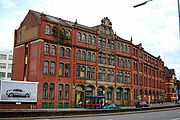
Birmingham Battery and Metal Company
The Birmingham Battery and Metal Company was founded in 1836 with a factory in Digbeth, Birmingham.The company did not make batteries, but the use of the word battery in the name refers to a method of metal production and forming .-History:In 1850 the company was described as "manufacturers of...
which moved to Selly Oak
Selly Oak
Selly Oak is a residential suburban district in south-west Birmingham, England. The suburb is bordered by Bournbrook and Selly Park to the north-east, Edgbaston and Harborne to the north, Weoley Castle and Weoley Hill to the west, and Bournville to the south...
around 1876, and Typhoo Tea who had a factory on Bordesley Street which was in use from 1896 till 1978. The now-disused factory has its own canal
Canal
Canals are man-made channels for water. There are two types of canal:#Waterways: navigable transportation canals used for carrying ships and boats shipping goods and conveying people, further subdivided into two kinds:...
basin connected to the Digbeth Branch Canal. The Typhoo Tea building, also known as the S Rose & Co Building, is a four storey building, blue brick at the front (Bordesley Street) and red brick to the rear. Currently vacant, it was previously used as a warehouse. Another food industry that settled in Digbeth was Alfred Frederick Bird's custard company
Bird's Custard
Bird's Custard is the original version of what is known generically as custard powder. It is a cornflour -based powder which thickens to form a custard-like sauce when mixed with milk and heated to a sufficient temperature...
that produced a form of custard
Custard
Custard is a variety of culinary preparations based on a cooked mixture of milk or cream and egg yolk. Depending on how much egg or thickener is used, custard may vary in consistency from a thin pouring sauce , to a thick pastry cream used to fill éclairs. The most common custards are used as...
that did not use eggs. This was invented by his father, Alfred Bird
Alfred Bird
Alfred Bird was a British food manufacturer and chemist. He was born in Nympsfield, Gloucestershire, England in 1811 was the inventor of a series of food products mostly now taken for granted...
. The factory was set up in the Devonshire Works
Custard Factory
The Custard Factory is an arts and media production centre in Birmingham, England .Located on the redeveloped site of the Bird's Custard factory in the industrial district of Digbeth, it is home to a community of businesses, primarily with an artistic and media slant, but also including...
in 1902 on the High Street. The complex expanded and is now an arts centre. The Devonshire Works themselves are to be refurbished.
Part of the Custard Factory complex is the Deritend Library, Birmingham's oldest surviving library
Library
In a traditional sense, a library is a large collection of books, and can refer to the place in which the collection is housed. Today, the term can refer to any collection, including digital sources, resources, and services...
building. The library opened on 26 October 1866 and was the third free district library to open in Birmingham. The library re-opened in 1898 following enlargement as a result of its popularity. Deritend Library closed on 16 November 1940. In 2003, it was opened as a conference centre and exhibition space. It is the only building of the original five free Birmingham libraries still standing.
The library building is located on Heath Mill Lane, which, along with Floodgate Street, provide information on the character of pre-industrial Digbeth. The River Rea once flowed unaffected by human development through Digbeth, cutting both the High Street and Floodgate Street in two. The 'Floodgates' were used when the river flooded. Heath Mill Lane meanwhile was named after the watermill
Watermill
A watermill is a structure that uses a water wheel or turbine to drive a mechanical process such as flour, lumber or textile production, or metal shaping .- History :...
used for grinding corn which had stood there since the 16th century. The River Rea is now hidden from view. Digbeth also had an abundance of natural springs which were gradually built upon as industry moved into the area. The existence of these springs and wells in the area are reflected in the street names such as Well Street.
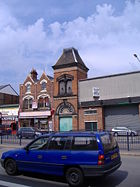
Other notable buildings in Digbeth, include the now-defunct The Clothing Mart operated by George Makepeace at 135-6 Digbeth which was designed by James Patchett of Ombersley
Ombersley
The village of Ombersley is in the Wychavon District Council area of Worcestershire.The first known reference to the village was the granting of a Charter to Abbot Egwin, later Saint Egwin, of Evesham Abbey in 706 AD. This was the Charter of King Æthelweard of the Hwicce, which granted twelve...
. Built in 1913, it is a steel framed structure with a mixture of façade materials. The façade consists of bright red brick and orange terracotta. The building is no longer used by George Makepeace and has changed hands, undergoing a variety of uses. Several aspects of its original architecture have been lost including a first floor iron balcony, above which electric lanterns with hooded lenses from two iron holders that remain. Either side of these were iron and glass lamps resembling Medici goblets. The orange pilasters sit on a key stone and pedimented blocks set with round pink granite stones and the parapet is of green glazed terracotta.
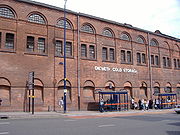
Rowton Houses
Rowton Houses were a chain of hostels built in London, England by the Victorian philanthropist Lord Rowton to provide decent accommodation for working men in place of the squalid lodging houses of the time....
, now known as the Paragon Hotel.
Digbeth was also of importance in 19th century transport with many coaches and carriers terminating at inns there. Inns that were particularly popular as such locations were The White Hart, the Red Lion, and The Bull's Head. This transport history is reflected in the creation of Digbeth Coach Station (now Birmingham Coach Station, which was built in 1929 by Midland Red
Midland Red
Midland Red was a bus company which operated in the English Midlands from 1905 to 1981. It was the trading name used by the Birmingham and Midland Motor Omnibus Company , which was renamed Midland Red Omnibus Company in 1974...
.
In the second half of the 19th century, an Italian quarter began to develop in the Fazeley Street area of Digbeth, with many immigrants from Italy
Italy
Italy , officially the Italian Republic languages]] under the European Charter for Regional or Minority Languages. In each of these, Italy's official name is as follows:;;;;;;;;), is a unitary parliamentary republic in South-Central Europe. To the north it borders France, Switzerland, Austria and...
settling in the area. However, this community was largely broken up in World War II
World War II
World War II, or the Second World War , was a global conflict lasting from 1939 to 1945, involving most of the world's nations—including all of the great powers—eventually forming two opposing military alliances: the Allies and the Axis...
due to the damage of buildings from the Luftwaffe
Luftwaffe
Luftwaffe is a generic German term for an air force. It is also the official name for two of the four historic German air forces, the Wehrmacht air arm founded in 1935 and disbanded in 1946; and the current Bundeswehr air arm founded in 1956....
, as well as many Italian residents being held in prison camps due to the fact that Italy was an enemy to Britain in this conflict.
These days Digbeth is often considered to include Deritend.
Etymology
The name Digbeth is derived from "dyke path". However, Digbeth is also believed to have originally been called 'Duck's bath' in reflection of the water supply in the area. It has also been suggested that it comes from “dragon’s breath”, referring to air pollution during the industrial revolution.Present day
Modern-day Digbeth is currently dominated by old industrial buildings and the blue-brick VictorianVictorian era
The Victorian era of British history was the period of Queen Victoria's reign from 20 June 1837 until her death on 22 January 1901. It was a long period of peace, prosperity, refined sensibilities and national self-confidence...
railway viaduct
Viaduct
A viaduct is a bridge composed of several small spans. The term viaduct is derived from the Latin via for road and ducere to lead something. However, the Ancient Romans did not use that term per se; it is a modern derivation from an analogy with aqueduct. Like the Roman aqueducts, many early...
. Digbeth is also home to Birmingham Coach Station which is operated by National Express
National Express
National Express Coaches, more commonly known as National Express, is a brand and company, owned by the National Express Group, under which the majority of long distance bus and coach services in Great Britain are operated,...
, Britain's largest express coach network.
New developments include the Irish Quarter, the Arts and Media Annexe of South Birmingham College
South Birmingham College
South Birmingham College is an establishment of further education in Birmingham, England providing full-time and part-time courses for young students following their period of compulsory education and for adults...
and the Custard Factory
Custard Factory
The Custard Factory is an arts and media production centre in Birmingham, England .Located on the redeveloped site of the Bird's Custard factory in the industrial district of Digbeth, it is home to a community of businesses, primarily with an artistic and media slant, but also including...
, a development designed to represent modern arts and music. Work to the Custard Factory has already seen the renovation of a number of buildings. Devonshire House, a Grade II listed building, is to be refurbished by S. B. Gray into studio and gallery space. The windows are to be replaced and a sculptural bridge will be installed in the building. The scheme has been designed by Weedon Partnership Architects
Harry Weedon
Harold William "Harry" Weedon was an English architect. Although he designed a large number of buildings during a long career, he is best known for his role overseeing the Art Deco designs of the Odeon Cinemas for Oscar Deutsch in the 1930s...
.

Glenn Howells
Glenn Howells is a British born architect. His practice, Glenn Howells Architects, has offices in Birmingham and London. Howells founded his practice in London in 1990 but later moved the main office to Birmingham in 1992....
. Much of the Typhoo building is to be demolished, although the front, rear and one of the side façades would be retained with the internal structure removed and replaced with new build based upon the original pattern of the internal wings. The development would consist of a three storey build up to the top of the front façade, a four storey build to the rear façade and a six storey build on the internal wings set back from both the front and the rear. It will consist of 342 dwellings (including 230 one bed flats, 112 two bed flats), seven units, 800 m2 of commercial space and a gym for the residents. The site area is 1.12ha
Hectare
The hectare is a metric unit of area defined as 10,000 square metres , and primarily used in the measurement of land. In 1795, when the metric system was introduced, the are was defined as being 100 square metres and the hectare was thus 100 ares or 1/100 km2...
and lies within the Warwick Bar
Warwick Bar
The Warwick Bar conservation area is a conservation area in Birmingham, England which was home to many canalside factories during the Industrial Revolution of the eighteenth and nineteenth centuries....
Conservation Area. The masterplan includes reference to the heights of the proposed building and shows to be between three and eight storeys on parts of the site. The proposals also include the reinstatement of the third arm of the canal basin to full standard and allows for the mooring of houseboat
Houseboat
A houseboat is a boat that has been designed or modified to be used primarily as a human dwelling. Some houseboats are not motorized, because they are usually moored, kept stationary at a fixed point and often tethered to land to provide utilities...
s. The overall cost of all developments in the area is expected to be £400 million by 2009.
Digbeth is affected by two conservation area
Conservation area
A conservation areas is a tract of land that has been awarded protected status in order to ensure that natural features, cultural heritage or biota are safeguarded...
s: Digbeth, Deritend, and Bordesley High Streets Conservation Area and the Warwick Bar Conservation Area. Both conservation areas are alongside each other. The Digbeth, Deritend, and Bordesley High Streets Conservation Area was designated on 31 May 2000 and has an area of 28.68 Ha (70.86 acres), covering all of Digbeth. The Warwick Bar Conservation Area was designated on 25 June 1987 and has an area of 16.19 Ha (40.00 acres). It extends outside of Digbeth, along the Digbeth Branch Canal through Eastside.
Culture
The area is associated with the development of the BritishUnited Kingdom
The United Kingdom of Great Britain and Northern IrelandIn the United Kingdom and Dependencies, other languages have been officially recognised as legitimate autochthonous languages under the European Charter for Regional or Minority Languages...
electronic music scene. As well as the Custard Factory
Custard Factory
The Custard Factory is an arts and media production centre in Birmingham, England .Located on the redeveloped site of the Bird's Custard factory in the industrial district of Digbeth, it is home to a community of businesses, primarily with an artistic and media slant, but also including...
, Digbeth is home to The HMV Institute
Digbeth Institute
Digbeth Institute is a civic building in Digbeth, Birmingham, England.It is now operated as the hmv Institute, a 2,400 capacity music venue...
which was a prominent venue during the early days of the rave
Rave
Rave, rave dance, and rave party are parties that originated mostly from acid house parties, which featured fast-paced electronic music and light shows. At these parties people dance and socialize to dance music played by disc jockeys and occasionally live performers...
music scene and underwent a revival in 1998 when superclub
Superclub
Superclub is a term used to refer to a nightclub owned and managed by a dance music record label, such as The Haçienda club, which was owned by Factory Records...
Godskitchen
Godskitchen
Godskitchen is an international superclub brand which is associated with dance music and organises events, particularly in the UK and US. The company runs a club night of the same name at their nightclub AIR, in Birmingham, England and has an in-house music label...
began to promote a weekly event there. Godskitchen is now based at its own venue, AIR (formerly CODE). All three venues are within a stones throw of each other.
Ikon Eastside
Ikon Eastside
Ikon Eastside is an art gallery in the Digbeth area of Birmingham, England.The gallery opened in 2006 as a second venue for the long-established Ikon Gallery in Brindleyplace...
, a branch of the Ikon Gallery
Ikon Gallery
The Ikon Gallery is an English gallery of contemporary art, located in Brindleyplace, Birmingham. It is housed in the Grade II listed, neo-gothic former Oozells Street Board School, designed by John Henry Chamberlain in 1877. The gallery's current director is Jonathan Watkins.Ikon was set up to...
is based in Digbeth. Eastside Projects
Eastside Projects
Eastside Projects is an artist-run space as public gallery in Digbeth, Birmingham, England.Eastside Projects was conceived by artist-curator Gavin Wade and is organised by a founding collective comprising Simon and Tom Bloor, Céline Condorelli, Ruth Claxton and James Langdon...
is an artist-run space
Artist-run space
An artist-run space is a gallery space run by artists, thus circumventing the structures of public and private galleries.Artist-run spaces have become realised as an important factor in urban regeneration...
that opened in 2008, and is situated on Heath Mill Lane, Digbeth.
Irish Quarter
Digbeth has very close links with the Irish community of BirminghamBirmingham
Birmingham is a city and metropolitan borough in the West Midlands of England. It is the most populous British city outside the capital London, with a population of 1,036,900 , and lies at the heart of the West Midlands conurbation, the second most populous urban area in the United Kingdom with a...
. It is increasingly also known as the Irish Quarter. The traditional St Patrick's Day parade is held in and around Digbeth, usually attracting crowds at times estimated to be one hundred thousand strong, making it the largest in the country.
A number of Irish theme pubs are resident, with the most notable being "The Dubliner" which was severely damaged by fire in July 2006. Immediately after the fire, there was a large swell of support for the pub to be rebuilt. The pub reopened 18 months later in January 2008.
The Irish Centre, facing Digbeth High Street, is to be rebuilt as part of a large regeneration project named Connaught Square. The scheme has been submitted for planning approval to Birmingham City Council
Birmingham City Council
The Birmingham City Council is the body responsible for the governance of the City of Birmingham in England, which has been a metropolitan district since 1974. It is the most populated local authority in the United Kingdom with, following a reorganisation of boundaries in June 2004, 120 Birmingham...
and was designed by RG+P of Leicester
Leicester
Leicester is a city and unitary authority in the East Midlands of England, and the county town of Leicestershire. The city lies on the River Soar and at the edge of the National Forest...
. The 4.544 acre/1.839 hectare site is to be developed by Dublin-based Naus Group at a cost of £150 million. The scheme will consist of 631 new apartments, a 180-bed four star hotel incorporating 36 serviced apartments, shops, offices, bars, restaurants in six buildings of between 4-7 storeys rising to 10 storeys. There will also be more than 1,000 underground car parking spaces, two new public squares and public amenity space. Around 800 jobs are expected to be created. Two pools of water are to be created above the course of the River Rea
River Rea
The River Rea is a small river which passes through Birmingham, England. The name of the river derives from a root found in many Indo-European languages and means "to run" or "to flow". It frequently bursts its banks after heavy rain....
which flows below the site. The White Swan public house
Public house
A public house, informally known as a pub, is a drinking establishment fundamental to the culture of Britain, Ireland, Australia and New Zealand. There are approximately 53,500 public houses in the United Kingdom. This number has been declining every year, so that nearly half of the smaller...
will be retained and incorporated into the development. Demolition work has already commenced and construction is anticipated to begin in early 2008. The hotel will be ready for occupation by 2009, with the scheme as a whole complete by 2011.

